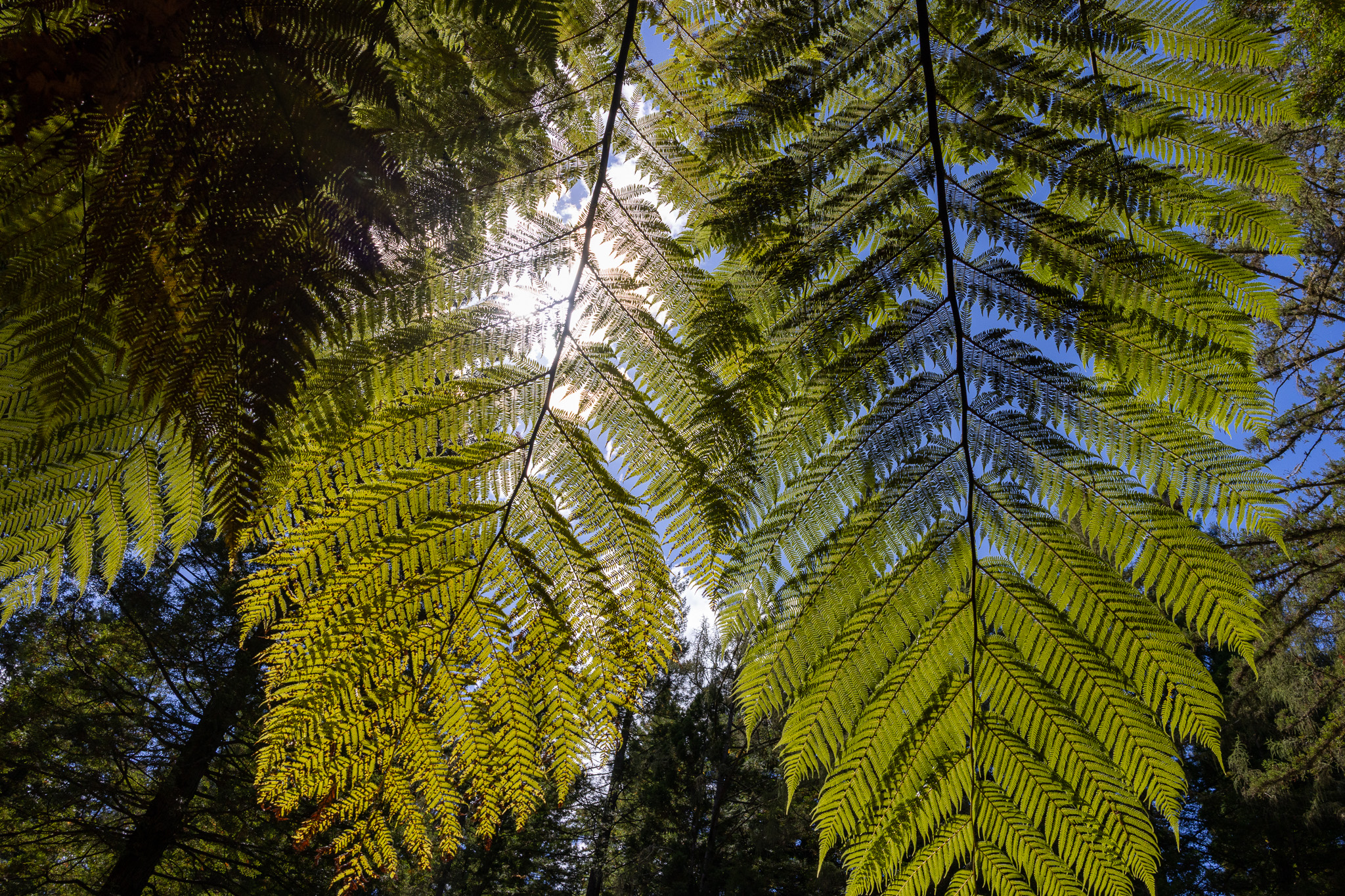The tour I took today offered me choices of what I wanted to see in Rotorua. I have seen geysers and hot springs. I did not want to go to a spa and sit in the hot springs, so my choices were to see the Village and the Redwood Tree walk.

I will admit, I had low interest in seeing this, but it was the one thing on the list after the village visit that I had not seen before. Having said that, this is not California.
California Redwood Sequoia Sempervirens are the tallest living trees on earth. In California, the trees can reach over 115 meters in height, 9 meters in diameter, and in the US some are over 2,000 years old. This is not California.

The Whakarewarewa Forest was planted in 1901. The tallest redwood here is 72 meters high and 2 meters in diameter. The faster growing New Zealand version of the redwood produces a softer wood than the slow growing California version.

Redwoods take their name from the tree’s heartwood which is a light cheery color and can darken to nut-brown when exposed to air. Because of the timber, the trees were brought here and plantations were established. Which is what this is, and why we know exactly when trees were planted.
There are all kinds of plantation forests in New Zealand, which continue to thrive because forestry is one of New Zealand’s most valuable export industries.
Since the native trees grew so slowly, they looked to ‘exotic’ trees to provide a faster growing alternative for the timber needs. Of course, that proved to be a mixed bag because the ‘exotic’ or ‘non-native’ species did provide more timber, but they were invasive and overtook many of the native species.
once again, man pretending to be god. But here we are, so we roll with it.
This forest is now an attraction to educate people about trees. And to create art. David Trubridge was commissioned by the Redwood Treewalk to design a light display to bring the redwood forest to life at night.
Okay, neat, and I did not see the display at night, but I am wondering if they turn out the lights at 10 or something because… they also are working in partnership with a local group called Wingspan which supports birds in the forest. The birds they apparently support are the Ruru/Morepork Owl and the non native Barn Owl. Both of which hunt at night, and both of which have eyes adapted to low or no light. So, lighting up the forest at night, at least on the surface after reading the signs posted around the forest… appears to be counter productive to having owls want to live there. But that might just be me.
Anyhoo… Mr. Trubridge is an environmentally responsible designer who used a specially made composite timber on a stainless-steel frame for his lights. The composite timber is made from the wood waste of New Zealand grown radiata pine bonded with non toxic adhesives suitable for 50 years of outdoor use. So, there you go.

The walkway through the forest is suspended from the trees using a specially designed sling which wraps around the redwood trunks without causing the tree any harm. As the trees grow, the slings can be easily adjusted to allow for the growing trees.
The platform sections were completed on site and were manually winched in parts up to the tree to minimize disturbance to the forest.
A specialist climbing team was brought out from Germany to install the platforms and walkway to avoid needing to use cranes or other large equipment.
The starting height of the walk is 6m and goes to the highest point of 12m. The length of the walk is 553m, with the longest bridge being 37m. In total, there are 23 bridges and 22 platforms

The Redwood trees are conifers, meaning they are cone bearing woody, seed plants. 20 species are only found in New Zealand, but there are around 700 species around the world.
Redwood trees are ‘monoecious.’ That is a fancy word that tells you each tree produces male and female cones. The male cones produce pollen, and the female cones produce seeds. So now you know something about pine cones. or at least redwood pine cones.

New Zealand is really into ferns. I only mention that now because they are all over this forest floor. There are over 70 species of fern in the Rotorua area alone, and 200 species across the country.

These, I believe, are giant mamaku tree ferns, and I only say that because they are really big. I might be entirely wrong.
Depending on what storyteller you believe, ferns have been a huge part of New Zealand identity since the Māori arrived. One type of fern here (I did not see one, but I like this story) is the silver fern. It is called that because the bottom of the leaf is a silver color.
Long ago, someone figured out that they could take the silver fern leaf when they went off hunting and they would drop bits of it along the path. When they wanted to return home, often after dark, the silver side would reflect the moonlight and thus sparkle and guide them back to their camp.
Since that was figured out it became a symbol of returning. Women would give silver leaf ferns to the men before they left for war in hopes it would help them find their way safely back home.
Eventually, that led to the silver fern being used on everything from sports jerseys to patches for soldiers uniforms.

Bonus side note because I want to test my kids later… in 1905 the “Originals” were the New Zealand national rugby team and they were the first to tour outside of Australasia, going to the British Isles, France and the US. They proudly displayed the silver fern on their all black uniforms during the trip and they won 34 of 35 matches. The British press coined the team the “All Blacks” during the tour because of the uniforms, and now the “All Blacks” are world champions in rugby.

Along the Redwood path, they throw a lot of statistics at you. For example, they tell you, given ideal conditions, the only thing that limits the height of a tree is gravity. As a tre grows taller, it is harder to get water up to the leaves. They use the example of the trunk being a giant drinking straw. The taller the straw gets, the harder it is to suck up the water, which rather suggests the giant redwoods really suck it up. Perhaps if we all did that, we would grow.
Somehow I do not believe that is the lesson they were trying to convey.
Rotorua’s 36 hectares of redwood trees sequester the carbon equivalent of 120 flights to London, the annual emissions of 167 cars and the carbon footprint of 27 people’s regular diet.
I guess every little bit helps, but that does not seem like a lot. Especially given the fact Forestry in New Zealand started here, and the intent was to cut down the forest, negating the great advantage of the forest.
So, everything I know about redwood trees, this forest, and New Zealand’s forest culture in general I have learned from the signs along the tree walk.
I found, at the end, I had more questions than answers. Frankly, I thought they contradicted themselves in purpose more than once.
So is this worth the visit? It is a nice walk through the forest. The only wildlife I saw were humans. I did learn something, which is always a good thing, and now I want to go to the redwood forest in California because I want to see firsthand how big these trees can get.
Other than that, don’t waste your money.

